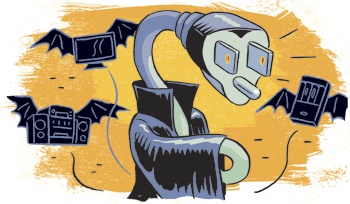Vampires have frightened people for generations. The fangs, the wings, the immortality: It’s scary stuff. Though that’s all legend—a subject for movies and Halloween costumes—a different breed of vampire could be lurking in your home right now. These vampires don’t drink blood; they consume electricity.
An energy vampire, also called a phantom or parasitic load, is any device that consumes electricity when turned “off.” These electronic devices provide the modern-day conveniences we love, but they also waste energy and cost us money.
According to a study conducted by the Lawrence Berkeley National Laboratory, the average home loses 8 percent of its monthly energy consumption to these energy vampires. A full 75 percent of the power used to run home electronics is consumed when those appliances are turned off, according to the U.S. Department of Energy.
Vampire loads can be found in almost every room of a home, though a favorite spot is the entertainment center. When the television is turned off, it isn’t really off. It’s sitting there, waiting patiently for someone to press the remote control’s on button—and waiting uses energy. TVs also use energy to remember channel lineups, language preferences and the time.
VCRs, DVD players, DVRs and cable or satellite boxes also use energy when turned off.
According to the National Rural Electric Cooperative Association, the average electric co-op residential member consumes roughly 13,900 kilowatt-hours (kWh) per year. If 8 percent of this power is consumed when electronics are turned off, the average home wastes 1,112 kWh annually. Assuming a cost of 10 cents per kWh, the average household spends $111 per year to pay for these vampire loads.
The good news is that a sharp stake isn’t necessary to kill off these vampires. To eliminate the power consumption of an energy vampire, simply unplug the device or plug it into a power strip and use the power strip’s switch to eliminate electricity to everything plugged into it. Power strips work like an extension of the wall outlet. They cut all power to plugs when they are switched off.
There are numerous devices in the home that can be unplugged easily and safely, or plugged into a power strip, without causing any inconvenience. Computer equipment, such as printers, scanners, desktop computers and broadband modems, can be “unplugged” without harm. Cell phone, tool and other battery chargers also should be unplugged when not in use. Even though the charger is not charging anything, it is still drawing power.
A new device called the “smart” strip is beginning to find its way onto store shelves. Smart power strips allow you to plug devices into a specially marked section of the power strip so they will still have power when turned off. Other devices that can be turned off safely are plugged into the rest of the strip. This allows you to turn off parts of a home entertainment system, such as the stereo, DVD player or home theater audio system, without losing the ability to record programs to a DVR or having to reprogram the television every time you want to watch a show. To learn more about smart strips, go to www.chooserenewables.com.
For devices that cannot be turned off, consumers should look for Energy Star-certified devices or ask the salesperson about a device’s standby power consumption. There can be big differences in power consumption between manufacturers, and sometimes even between models from the same manufacturer.
As in the movies, it is impossible to kill off all of the energy vampires in your home—but every energy vampire vanquished will mean that much less of a bite out of your wallet.
——————–
Brian Sloboda is a program manager specializing in energy efficiency for the Cooperative Research Network, a division of the National Rural Electric Cooperative Association.


